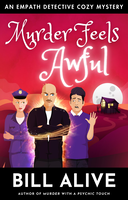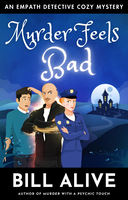Sneak Attack! Everything We Know on This Is Wrong...
Alas … Everything Has Changed.
I was gunning hard to finish the rough draft for the next Mark and Pete comedy mystery adventure by next Friday. It was tight, but still gloriously possible. Then… this happened…
The dreaded Sneak Attack. The gut-wrenching choice.
Turns out, there’s this crucial storytelling issue where everything we think we “know” is wrong. And for real, this ignorance could get you killed.
BUT FIRST, AS ALWAYS, THANK YOU FOR YOUR EMAILS!!
Before I go there, though, I want to thank you all for continuing to send me awesome, encouraging emails. Thank you so much, you are awesome.
Don’t be discouraged if I haven’t written you back yet. I’m planning on a massive reply fest after I finish this draft. 😄 But I’m already reading every single email and again, thank you. This is a whole new experience for me, to have so much support as I write. It’s amazing.
I was especially pleased to hear from some fellow writers! I love talking about writing, so I’m very happy that some of you found last week’s talk about the “scene beat” technique so helpful.
SO WHAT'S ALL THIS ABOUT A "SNEAK ATTACK"?
Last week, I was working through the final act of that “scene beat”, plotting out the key moments of every single scene. What I didn’t mention last time was that as I plotted, I was also making a list of last-minute questions to research.
Sure, I’d already done plenty of research ahead of time. So I really expected that I’d only need to spend a few hours, at most, hunting down the last loose ends before I could dive into the draft.
Well.
I set out expecting a quick dig for answers that lay just under the surface. Instead, I triggered a cave-in … and tumbled into vast, dark caverns of ignorance.
I had plotted multiple key scenes that hinged on “facts” that turned out to be preposterous.
And you know what? It makes me mad.
Because I’d absorbed those “facts” from countless other books and movies that blithely passed along a hallowed tradition of complete … shall we say, bovine manure.
I can’t get into all the details yet, not without some serious spoilers. But for now, I can come clean on one core issue.
Unless you have direct experience, everything you “know” about guns is wrong.
GUNS? REALLY? BIG SURPRISE, I ALREADY KNOW MOVIES LIE ABOUT GUNS.
No, really, you don’t. Not unless you fire guns in real life.
Sure, you’ve probably joked about, say, Movie Six-Shooters With Infinite Bullets. But that’s just the start. Seriously, by the time you list out all the ways movies get guns wrong, they may as well be featuring some alien technology.
Movie gunfights have almost nothing in common with the way physics works for firearms, bullets, and the human body.
HMM. SO HOW DO MOVIES GET GUNS SO WRONG?
Here is a short, off-the-top-of-my-head, I-have-a-draft-to-write list to get you started:
In the movies, if the gun can’t see you, the bullet can’t hit you. Heroes hide behind car doors, sheetrock walls, and couches. One blog had a scene from Grosse Pointe Blank where a “professional assassin” is literally taking cover behind a display of potato chips. Which gets shot up. But John Cusack is fine.
In real life, bullets go through almost anything. If you’re a bad guy, just fire through the stupid wall. This also means that if you misfire at a home intruder, you could kill your kid upstairs. Also, there are weird exceptions; a bullet can get slowed down by seemingly random, non-cinematic items like, oh, a few feet of water. Except even that depends … different guns might need up to 8 feet or more. Do you see a trend here? All our “intuitive” guesses are totally wrong.
In the movies, the hero is always surprised when he runs out of bullets.
In real life, that’s about as likely as getting surprised you ran out of gas Especially if hitting E would get you killed.
In the movies, anything except a direct head or chest shot is a “flesh wound”. A hero can take a shot to the knee and, a few scenes later, forget to keep limping. She can also show her moral superiority by opting not to execute a baddie, choosing a merciful shot to the shoulder instead.
In the real world, the only “safe” places to get shot are your butt or your shins. At least, I found that suggestion in two different places. And I didn’t even find out yet how long it takes to heal from those complications … or how your shin bones might feel about the shrapnel. Bullets and flesh don’t play well together. Wherever the bullet enters, it can ricochet and do all kinds of crazy nastiness inside your body. Plus, you tend to have major arteries in inconvenient places.
In the movies, heroes chitchat as they fire round after round. In real life, guns are LOUD. On the battlefield, you can’t hear each other scream. Those “pfft” silencers are completely bogus; silencers do exist, but all they do is dampen the sound enough to disguise the location of the shooter. Also, the insane din of gunfire is the reason for all those military hand signals. They’re not to be sneaky, they’re so soldiers can still communicate when their hearing is, um, shot.
In the movies, characters are always ready to point a gun to extract info, intimidate, and generally make the conversation more intense. In real life, you only pull a gun if you’re willing to kill. This might not be universally true for all shooters, but it was a key point in a fascinating book geared to gun-ignorant writers called Throwing Lead: A Writer’s Guide to Firearms. (A book I inhaled over the weekend.)
In the movies, a bullet wound can catapult you through the air. In real life … no. The closest is a shotgun, which sends a spray of bullets that can sometimes knock an assailant back. But even then, no flying.
In the movies, fatal gunshots kill almost instantly. In real life … no. In fact, one point I saw over and over again is that not only can shot people take awhile to die, they can keep fighting and shooting back. The good news is, if you get to a hospital in time, your chances of survival for most gunshots are high. But note the word choice: survival. Possibly survival with a complete mess inside…
Meanwhile, for a hero, months of physical therapy can really kill dramatic tension…
I could go on, but this is already getting too long.
OKAY, BUT DOES THIS COMPLETELY FALSE IMAGE OF GUNS REALLY MATTER?
Yes. For one thing, this fake “knowledge” can get you either killed or seriously maimed.
This guy in Texas pulled out a shotgun to scare off a home intruder. The intruder appropriately screamed and took off. The guy pulled out his phone to call the police, and, being somewhat nervous and sweaty, dropped the phone. In his fumbling, he also dropped the shotgun.
Pop quiz: what happened next? I bet your movie-trained brain eagerly guesses: “When the gut hit the ground, it shot on its own!” That was my guess.
NO, THAT IS TOTALLY WRONG.
Even though dropped guns firing on their own is in a gazillion movies, gun manufacturers really don’t want that to happen. I’m sure it’s possible, but it’s unlikely. The real-life safety tip is: let the gun drop, don’t try to grab it.
Our nervous Texan did try to grab it. And pulled the trigger.
His lower leg had to be amputated.
BUT IN YOUR STORY, SO WHAT? ISN’T IT JUST A STORY?
Here’s the thing. I definitely don’t aspire to complete “reality” when I tell stories. In a sense, the whole point of a story is to compress as many awesome, dramatic bits as you can into one implausibly exciting tale.
But on the other hand, stories should help us understand the real world. That includes fantasy and sci-fi, everything. For me, that’s a core belief. It’s central to why I write.
A little implausible fudging is one thing, fine. But past a certain point, misrepresenting real-life tech (and the physics of human anatomy) with such reckless indifference feels like a lie. It’s like characters that violate everything you know about how real humans actually act and think.
We all deserve better.
SO WHAT ARE YOU DOING ABOUT IT?
I’m going to take the time I need to get these scenes right.
It’s a tough choice: there’s a ton of pressure on authors right now to just write, write, write, spit out the next book. Sometimes I need this pressure or I’ll perfectionize for years. But if I really have to choose between speed and quality, quality wins. I’m writing for keeps.
So, bad news: this draft isn’t going to happen by next Friday.
Good news: I have the freedom to give the book the time it needs. Plus, this challenge has helped me build up momentum, so I’m putting in extra hours and still finishing it faster than I otherwise would.
And I also know to tweak my process: next time, do even more research before the scene beat.
When I set myself this challenge, my estimate was based on having “hardly any” research left. The dark truth is that I sometimes resist this research precisely because I know in my gut that I might discover a cavern of ignorance that needs proper exploration.
On the plus side, once I get past the initial disappointment, I love the learning.
And who knows, maybe one day you’ll let a gun drop … and I’ll have saved your leg. 😄
SO HAVE YOU STARTED DRAFTING YET?
Yes! I still need to do more research and work out those scenes, but yesterday I decided to just dive into the draft.
How’d it go? Well, truthfully, it’s been awhile since Pete and I hung out … so yes, there was some initial awkwardness.
But after a couple hours, it felt just like old times. I’m excited to start this draft .
And by the way, don’t let all this gun talk worry you that Mark and Pete are going to start slinging lead. No way. But I can only write so many mysteries without a bad guy thinking to carry a gun. 😄
GREAT. ARE YOU DONE? THIS WAS SO LONG!!
If you read this far, thank you! I know this was epic, but I really wanted to share at least a little of my paradigm shift about how guns work.
And if you’re a gun expert yourself, or you’ve read some stories that really got it right, let me know! I’d love to see how other authors get this right.
Now I’m off to my draft. If you’re celebrating the Fourth today, I hope you have a splendid time with your friends and family.
Happy reading! See you next week!
![[Bill Alive]](/images/authors/bill_alive_200x_mangos.png)
Bill Alive
P.S. I know this post is super long, but if you think you know about guns… nope. Might want to scroll up. Unless, of course, you actually use guns in real life, in which case I’d love to hear from you. What are your pet peeves with how writers do guns in books and movies?

